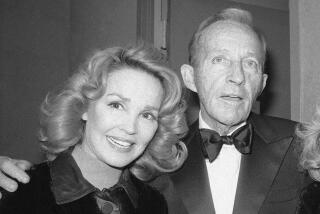From the Archives: Kitty Carlisle Hart, 96; actress, singer best known for tenure on quiz show ‘To Tell the Truth’
Kitty Carlisle Hart, an actress and singer who earned a niche in movie history by singing in the Marx Brothers’ “A Night at the Opera” but who achieved her greatest fame as a longtime panelist on television’s “To Tell the Truth,” has died. She was 96.
Hart, the widow of Pulitzer Prize-winning playwright Moss Hart and the former longtime chairwoman of the New York State Council on the Arts, died of congestive heart failure Tuesday night at her New York apartment, her son Christopher Hart said Wednesday. She had been in poor health since contracting pneumonia at Christmastime.
Kitty Carlisle, as she was known professionally, was a regular panelist on “To Tell The Truth” from 1956 to 1977 on both CBS and a syndicated version of the popular quiz show.
Its format was simple: Three contestants purporting to be the same person were introduced to the four panelists, whose role was to question the contestants and determine which one was telling the truth.
Among the show’s early contestants: aviator Douglas “Wrong Way” Corrigan, a concert pianist who was also a judo expert, a female professional bullfighter, Winston Churchill’s butler, President Eisenhower’s barber, a Venetian gondolier and the president of the Liars Club.
Each round ended with the master of ceremonies, originally Bud Collyer, uttering the famous line, “Will the real [person’s name] please stand up!”
The well-dressed, carefully coiffed Carlisle, a refined brunet with an opera-trained voice and precise diction, brought an air of sophistication and Manhattan glamour to the New York-based show.
As the wife of Hart, the celebrated Broadway playwright and director who died in 1961, Carlisle hobnobbed with the likes of the legendary Richard Rodgers, Alan Jay Lerner and George S. Kaufman.
The walls of her elegant Upper East Side apartment featured original artwork by friends Irving Berlin, Harpo Marx, Noel Coward and George Gershwin, who proposed marriage to her in the 1930s. (“I loved his talent, but I didn’t really love him,” she wrote in her 1988 book, “Kitty: An Autobiography.”)
She was born Catherine Conn in New Orleans on Sept. 3, 1910. Her strong-minded mother played a crucial role in Carlisle’s life, making her practice piano for two hours a day beginning at age 6. Her mother also began taking her to concerts and the opera.
“I was a shy, introverted child, and mother educated me, kept pushing me and gave me discipline; but she was too hard on me,” Carlisle told the Palm Beach Post in 2002. “She would say things like, ‘Your performance was fine, but that F-sharp was a little too acid, don’t you think?’
“Oh, boy! You know what that can do for you.”
After Carlisle’s father, a physician, died when Carlisle was 10, she and her mother moved to Europe.
“My mother wanted me to have a place in ‘society,’ ” Carlisle told the Boston Globe in 1988. “She thought a ‘suitable condition’ for a woman was a brilliant marriage. That meant marrying someone above my station.
“She knew you had to be in the right place at the right time to meet the right people. We had no money, so she learned the ropes well. We had the worst room in the best hotels in Europe, rooms under the eaves with no bath.”
Carlisle’s mother, however, managed to send her daughter to an exclusive private school in Lausanne, Switzerland. Carlisle also went to a finishing school in Paris and made her society debut in Rome.
But after she failed to land a suitably wealthy or titled husband after two social seasons, her mother told her she had two career options: acting or modeling.
Choosing the stage, Carlisle began dramatic training in Paris, then entered the Royal Academy of Dramatic Art in London while continuing voice and singing lessons.
In 1932, after she and her mother moved to New York City, Carlisle went on an open casting call and landed the title role in a touring company of the popular Broadway operetta “Rio Rita.” (She picked her euphonious stage name out of the New York City phone book.)
A year later, Carlisle made her Broadway debut in “Champagne, Sec,” an English-language version of Johann Strauss’ “Die Fledermaus.”
New York Times critic Brooks Atkinson called her performance “excellent,” and a critic for Theatre Arts Monthly praised the “unusual power” of her contralto voice and the “poise and polish” of her acting.
It was enough for Paramount Pictures to offer her a screen test and bring her out to Hollywood as a contract player.
She made her film debut in 1934 in “Murder at the Vanities,” a musical mystery in which Carlisle and Carl Brisson sang “Cocktails for Two,” which became a hit.
Carlisle then made two films with Paramount’s rising young star Bing Crosby: “She Loves Me Not,” a musical comedy in which she and Crosby introduced a song — “Love in Bloom” — that became a hit and later Jack Benny’s theme song; and “Here Is My Heart.”
On loan to MGM, Carlisle played the part of the ingenue opera singer in the 1935 comedy “A Night at the Opera,” which became one of the Marx Brothers’ biggest hits.
During filming, playwright Kaufman, who co-wrote the film, introduced Carlisle to two of his friends visiting from New York, Cole Porter and Moss Hart.
Carlisle was so excited by the prospect of meeting two of her show business heroes that she began running toward them. But she tripped over an electrical cable and, she later wrote, “fell flat at Moss’ feet.”
Their marriage would not come until a decade later, after they were reintroduced.
Carlisle’s stab at Hollywood stardom was cut short. After completing “A Night at the Opera,” Paramount bought out the remainder of her contract, and she moved back to New York.
She returned to Hollywood briefly in the ‘40s, appearing opposite Allan Jones in Universal’s 1943 musical “Larceny With Music” and appearing as herself in the star-filled 1944 Warner Bros. musical comedy “Hollywood Canteen.”
She spent the late ‘30s and early ‘40s appearing in various operettas and summer theater productions and singing in Manhattan supper clubs.
Then, in 1946, she married Hart. It was the first marriage for both.
“I was terribly unhappy before I got married,” Carlisle told the Washington Post in 1988. “I was getting older. And I had no children. My career was mostly in a downswing.”
She considered Hart “a genius, and therefore his career was much more important than mine,” she told the Post. “He took me to rehearsals. He consulted me on casting -- not that he ever took my advice.... I never felt left out.”
They had two children, Catherine and Christopher. Catherine, a doctor, and Christopher, a director, writer and producer, survive her, along with three grandchildren.
Carlisle once described the death of her husband as “the only real tragedy of my life.” She never remarried.
In the ensuing years, she became a passionate advocate for the arts, serving as vice chairwoman of the New York State Council on the Arts from 1971 to 1976, when Gov. Hugh Carey appointed her chairwoman, a job she held for 20 years.
Over the decades, Carlisle continued to perform occasionally on stage, most notably in “Die Fledermaus” at New York City’s Metropolitan Opera during the 1966-67 season; and she cropped up in an occasional movie, including Woody Allen’s “Radio Days.”
In 2002, at 91, she was still performing around the country in her one-woman show, “My Life on the Wicked Stage,” featuring songs and anecdotes about the American musical theater. It grew out of material she had developed in 1996 for a talk on the subject at the Metropolitan Museum of Art.
She was still performing until late last year.
Services are pending.
From the Archives: Dean Martin, Screen Star and Singer, Dies at 78
From the Archives: Elizabeth Montgomery Dies of Cancer
From the Archives: Lucille Ball Dies; TV’s Comic Genius Was 77
From the Archives: Bing Crosby Dies at 73 on Golf Course
From the Archives: Wally Cox, 48, ‘Mr. Peepers’ of TV Fame, Found Dead at Home
More to Read
Start your day right
Sign up for Essential California for the L.A. Times biggest news, features and recommendations in your inbox six days a week.
You may occasionally receive promotional content from the Los Angeles Times.






